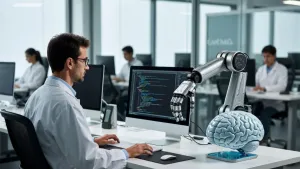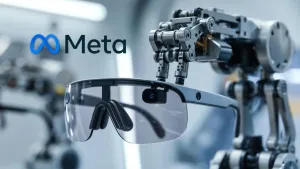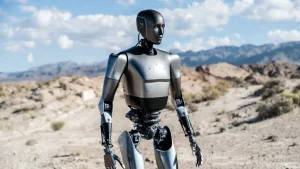The boundary between medical breakthrough and bold speculation blurs as a chilling simulation video captures robotic arms executing what looks like a human head transplant.
Shared widely on X by science communicator @ShiningScience, the footage shows dual robotic manipulators hovering over a supine figure, their articulated limbs poised with surgical tools. Screens above display vital-like readouts in glowing teal, evoking a sterile operating theater from a dystopian film.
The clip, clocking in at over eight minutes, animates the procedure step by step: incisions along the neck, careful disconnection of vascular lines, and seamless reattachment. Viewers react with a mix of awe and unease, from quips about insurance coverage to deeper concerns over psychological fallout.
🚨 The Future Is Here: A Head Transplant Machine? 🤯
— Shining Science (@ShiningScience) November 21, 2025
Imagine waking up one day and realizing the impossible may soon be possible.
A new concept called BrainBridge has just been revealed — and it claims to be the world’s first head transplant system powered by advanced robotics… pic.twitter.com/Wua4P2tR8A
At the core of this visualization lies BrainBridge, a conceptual system unveiled in early 2025 by a consortium of bioengineers and AI specialists. Proponents pitch it as the world's first integrated platform for cephalosomatic transplantation, swapping an entire head onto a donor body.
Targeted at terminal cases like advanced cancers or locked-in syndrome, the setup leverages multi-arm robotics akin to the da Vinci Surgical System, enhanced by AI for real-time tissue mapping and error correction.
"This isn't just fantasy; it's a blueprint for extending life where medicine currently fails," asserts Dr. Elena Vasquez, a neural interface expert at the project's advisory board.
The simulation draws from physics-based models that predict blood flow disruptions and nerve realignments with 95% accuracy in virtual trials.
Deep dives into the tech reveal roots in established robotic surgery advancements. NVIDIA's Isaac Sim platform, for instance, powers similar training environments where AI learns from surgical videos to mimic human dexterity.
Researchers at Johns Hopkins and Stanford recently demonstrated this with the da Vinci kit: robots trained via imitation learning matched expert surgeons in suturing tasks, cutting training time by an order of magnitude.
"We fed the system hours of footage, and it generalized to unseen scenarios without explicit coding," reports lead engineer Rajat Kumar in a 2025 NVIDIA Technical Blog post.
This zero-shot capability, executing novel actions from observation alone, fuels BrainBridge's promise. The system's AI, built on cascaded U-Net neural networks, detects landmarks like spinal cords with sub-millimeter precision, outperforming human consistency in soft-tissue anastomoses.
Yet, the road from simulation to scalpel demands rigorous validation. Historical precedents, like the 2017 monkey head transplant attempt by Italian surgeon Sergio Canavero, ended in paralysis due to immune rejection and spinal fusion failures.
Modern simulations address these via haptic feedback and deformable tissue modeling, as seen in Surgical Science's RobotiX Mentor. This VR trainer, validated in over 20 studies, embeds AI to score trainees on economy of motion and error rates, reducing real-OR complications by up to 30%.
A 2025 Science Robotics paper on the Smart Tissue Autonomous Robot (STAR) further bolsters optimism: an upgraded version reconnected porcine intestines autonomously, surpassing human benchmarks in accuracy. Trained on NVIDIA GPUs, STAR adapts to tissue variability, a feature BrainBridge adapts for cranial vasculature.
Ethical Concerns
Ethical storm clouds gather quickly. Bioethicists warn of consent dilemmas, who approves body donations?, and existential risks, like identity erosion post-transplant.
"The brain-body synergy isn't mere wiring; it's a holistic ecosystem," notes neurobiologist Dr. Marcus Hale in a PMC review on AI in robotics.
Regulatory bodies, including the FDA, classify such systems as high-risk devices, mandating phased trials: animal models by 2027, human feasibility studies no earlier than 2030.
Public discourse on X amplifies these tensions; one thread garners 96 replies debating psychosis from mismatched microbiomes, while another cites a 2023 Hiroshima University study on 3D-printed organ simulations as a safer pivot.
BrainBridge's architects counter with inclusivity, open-source elements invite global input, democratizing refinements. Collaborations with entities like the Intuitive Foundation already embed simulation data into hardware, accelerating proficiency.
As one X user quips, "This blurs sci-fi and surgery, immortality for the elite or equity in end-of-life care?" The simulation's virality, amassing 60,000 views overnight, highlights a major interest.
Robotic surgery, once niche, now claims millions of annual procedures worldwide, per a 2025 DeBakey CV Journal analysis. AI integration could standardize outcomes, easing surgeon fatigue and error rates.
Looking ahead, experts forecast hybrid models: robots augmenting human teams for 80% of tasks by decade's end. Pilot programs at UC San Diego test teleoperated humanoids for bedside exams, bridging to full autonomy.
For BrainBridge, success hinges on surmounting biology's final boss, the blood-brain barrier. If simulations translate, it redefines mortality; if not, it refines safer frontiers like facial reconstructions.
Either way, this video doesn't just shock, it signals medicine's next epoch. Researchers urge scrutiny: follow updates via NVIDIA's developer blogs and Science Robotics for trial timelines.
As Vasquez puts it, "We're not playing God; we're extending the game."
Note: 👉 This is a developing story and will be updated.





